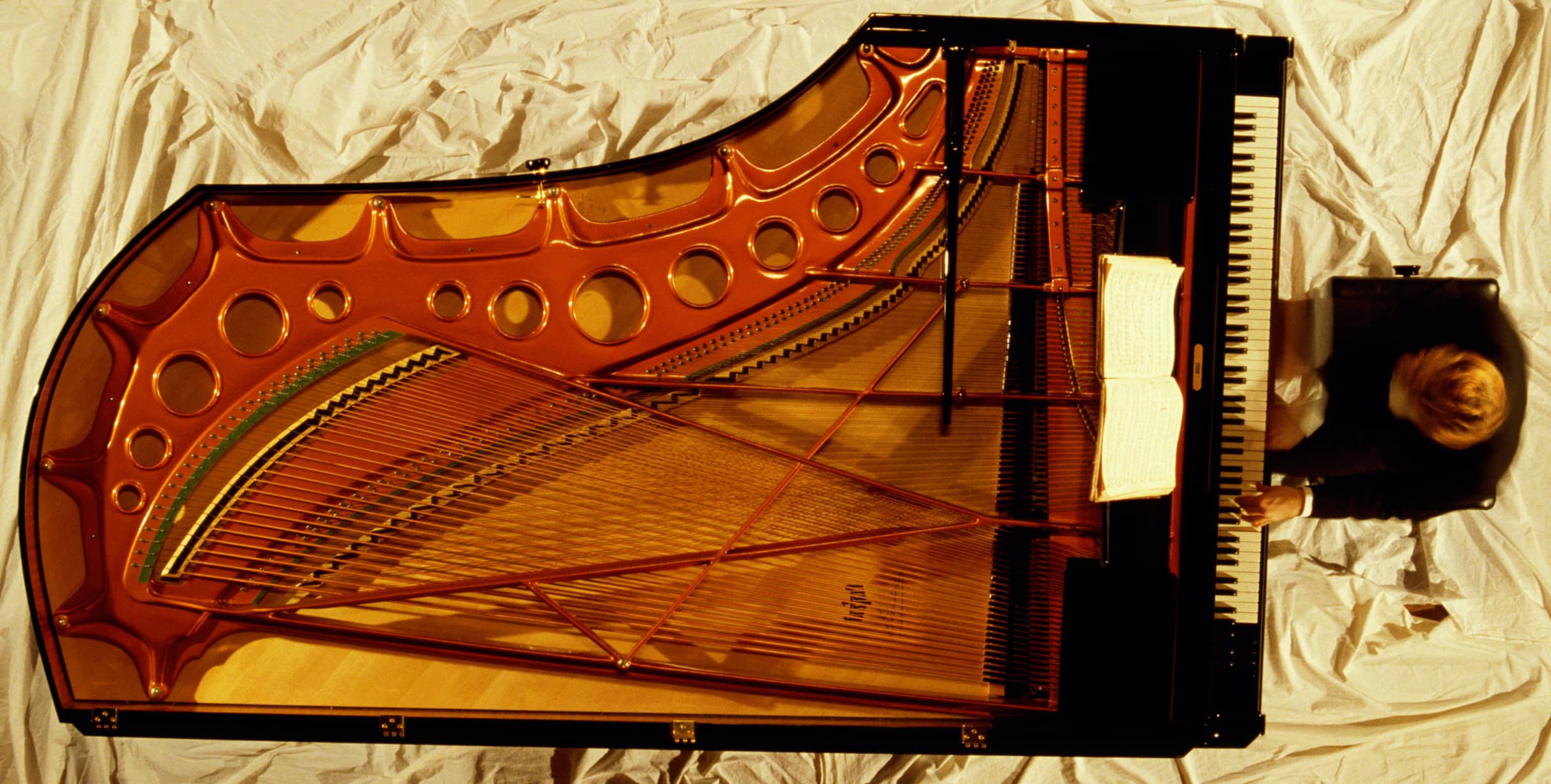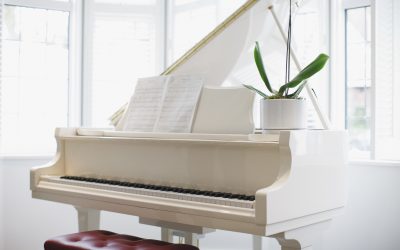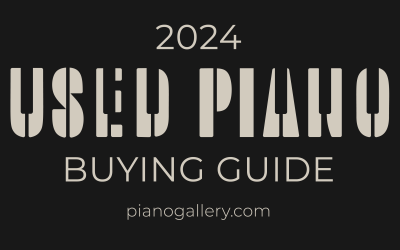
If you’re a piano player, can feel the magic of a grand piano as you play, your fingers moving across the keyboard with nuanced strokes that bring beautiful music that resounds through the instrument. Behind its elegant exterior lies a complex mechanism that translates the pianist’s touch into a symphony of sound. In this blog post, we’ll unravel how a grand piano works, from the key press to the room-filling music.
How a Grand Piano Works
A grand piano is a marvel of acoustics. The sound begins with the pressing of a key, which triggers a felt-covered hammer to strike tightly stretched strings. The force and speed of the hammer strike are influenced by the velocity with which the key is pressed. This dynamic range allows for the production of soft, mellow tones or loud, powerful crescendos. These strings vibrate, creating sound waves that resonate through the wooden soundboard, amplifying the tone. This interplay of physics and engineering allows pianists to produce a range of sounds, from gentle whispers to powerful crescendos.
1. The Key Mechanism
At the heart of the grand piano’s operation is the key mechanism. When a pianist presses a key, it sets off a series of events that ultimately produce sound. Each key is a lever, and as it is pressed, it lifts a hammer mechanism.
2. Hammer Action
The hammer action is a critical component in determining the quality of a piano’s sound. As the key is pressed, it causes the hammer to strike the strings. The precision of this mechanism ensures that each note can be played with distinct clarity and expression. Some piano brands have greater precision than others, making hammer action (or, simply, “action”) being one of the primary qualities an experience pianist will look for in a new or used piano.
Shop Used Grand Pianos
3. Strings
The strings are responsible for producing the actual sound. Grand pianos have strings of varying lengths and thicknesses, each corresponding to a specific pitch. The vibrations generated by the striking hammers travel through the strings and are then transferred to the soundboard.
4. The Soundboard
The soundboard is a large, thin wooden board positioned beneath the strings. Its role is to amplify and resonate the vibrations from the strings, enhancing the overall volume and richness of the sound. The soundboard is carefully crafted to ensure it vibrates freely and evenly across its surface.
5. Dampers and Sustain Pedal
To control the duration of each note, dampers are employed. When a key is released, the damper comes into contact with the string, stopping the vibration and ending the note. The sustain pedal, when pressed, lifts all the dampers simultaneously, allowing the strings to vibrate freely and creating a sustained sound.
6. Wooden Frame
The wooden frame of a grand piano is a crucial component. It provides the necessary support for the tension of the strings and contributes to the resonance of the instrument. The choice of wood and the construction of the frame are essential factors in determining the piano’s tonal quality.
7. Regulation and Tuning
Piano technicians perform regulation and tuning to ensure that the entire mechanism operates precisely. Regulation involves adjusting the action to achieve uniform response across all keys, while tuning ensures that each string produces the correct pitch.
What About That Large Metal Plate?
The metal part on the inside of a grand piano is called the “frame” or “plate.” This large, cast iron frame is crucial for a piano’s structure and sound. It supports the tension of the piano strings and maintains the piano’s structural integrity. The plate is also responsible for sustaining the immense string tension, which can be up to 20 tons in a concert grand piano. This component plays a key role in the piano’s ability to produce its characteristic sound and sustain long-term tuning stability.
The holes in a piano plate, also known as the cast iron frame, serve several important functions:
-
Reducing Weight: The cast iron plate is extremely heavy, and the holes help to reduce its overall weight without compromising its strength and structural integrity.
-
Acoustic Properties: The placement and size of these holes can influence the piano’s acoustic properties. They are designed to allow for optimal sound wave movement and resonance within the piano.
-
Aesthetic Design: In some pianos, the holes are also arranged in a way that contributes to the aesthetic design of the instrument.
Final Thoughts
A grand piano is not just a musical instrument; it’s a marvel of engineering and artistry. Understanding the intricate workings of its mechanism enhances our appreciation for the craftsmanship involved in creating these beautiful instruments. The next time you listen to the grandeur of a piano concerto, you can enjoy not only at the skill of the pianist but also at the mechanics that bring the music to life.
Shop Used Pianos
About the Author

Mikelle Despain
Piano Insights Author
Mikelle is a classically trained pianist and former piano teacher who has been in the piano retail industry for over 20 years. Her dream piano is a Yamaha S5X. She currently provides expert insights for Piano Gallery to share information and advice for buying, playing, and enjoying the piano. When she's not writing or playing piano, she's spending time with her four kids, tending her vegetable garden, boondock camping, hiking, or cooking overly-extravagant meals for friends.
Further Reading...
25 Best Baby Grand Pianos in 2024
25 Top Baby Grand Pianos in 2024 Baby grand pianos are cherished for their aesthetic appeal, accessible size, and the richness of their sound, making them a popular choice for both professional musicians and avid amateurs. Here, we delve into the 25 best baby grand...
Baby Grand Piano Buying Guide
Baby Grand Piano Buying Guide Baby grand pianos are a smaller version of a traditional grand piano. They are typically 5’ to 5' 6” in length (from the tail to the keyboard). High-quality baby grand pianos, such as the popular Yamaha C1X hold their value extremely...
2024 Guide: Best Grand Pianos For Your Family
© Piano Gallery 2024“When I had nothing else, I had my mother and the piano. And you know what? They were all I needed.” Alicia Keys Buying a grand piano for your family is no casual matter. People develop deep connections with musical instruments that often start at...
What is the Difference Between a Baby Grand Piano and Grand Piano?
Grand pianos and baby grand pianos are the epitome of a classic icon in music. With their elegant curves, propped lids, and exposed strings and soundboard, their beauty is often one of the first things people think of when considering a grand or baby grand piano. In...
2024 Best Beginner Pianos: A Complete Guide to Buying a Beginner Piano
© Piano Gallery of Utah 2024 If you’re looking to add a piano to your home for yourself or family members to learn to play on, then get ready for an exciting journey. Playing the piano is a lifelong passion for most players and brings music and joy to the home, as...
How Much Does a Baby Grand Piano Cost?
A baby grand piano is often chosen by musicians and enthusiasts not only for its elegant aesthetic, which enhances any room, but also for its rich, resonant sound quality that is superior to that of smaller pianos. Despite being more compact than a concert grand, a...
How Much Does a Piano Cost?
The cost of a piano varies widely based on its type, brand, condition (new or used), and the intricacies of craftsmanship involved in its manufacturing. In this article, our piano experts share price ranges for the main types of pianos, explain what impacts the...
Tips for Buying a Used Piano
2024 Used Piano Buying Guide Pianos are well-regarded as holding their value well, making used pianos a popular purchase, especially for new piano buyers or those looking to upgrade their pianos without a significant financial investment. Many pianos can hold their...
Complete Yamaha Disklavier Guide for 2024
In music, innovation often means striking a balance between preserving traditional craftsmanship and embracing modern technology. Yamaha, world renowned for its instruments, has mastered this balance with its Disklavier pianos, which combine a rich, resonant, classic...
Buying a Piano for Christmas? 12 Ideas for Surprising your Family with the Piano
A piano is one of the most memorable Christmas gifts your family can receive. Unlike some gifts, it's not played with for a few weeks then forgotten, it doesn't disappear into a closet until spring cleaning, it isn't quickly replaced by a new obsession or hobby, and...
10 Resolutions for Piano Players in 2024
For many of us, New Year's resolutions are heavy with responsibility, usually including health and exercise, work and finances, and even family relationships. One thing often overlooked in the resolution process is fun hobbies or passions such as playing the piano....
A Guide to Buying a Piano as a Family Christmas Gift
The holiday season is a time of joy, togetherness, and creating lasting memories with our loved ones. If you're searching for a gift that will bring joy into your home, consider the timeless and elegant gift of a piano. How to Buy a Piano as a Gift Even though the...











